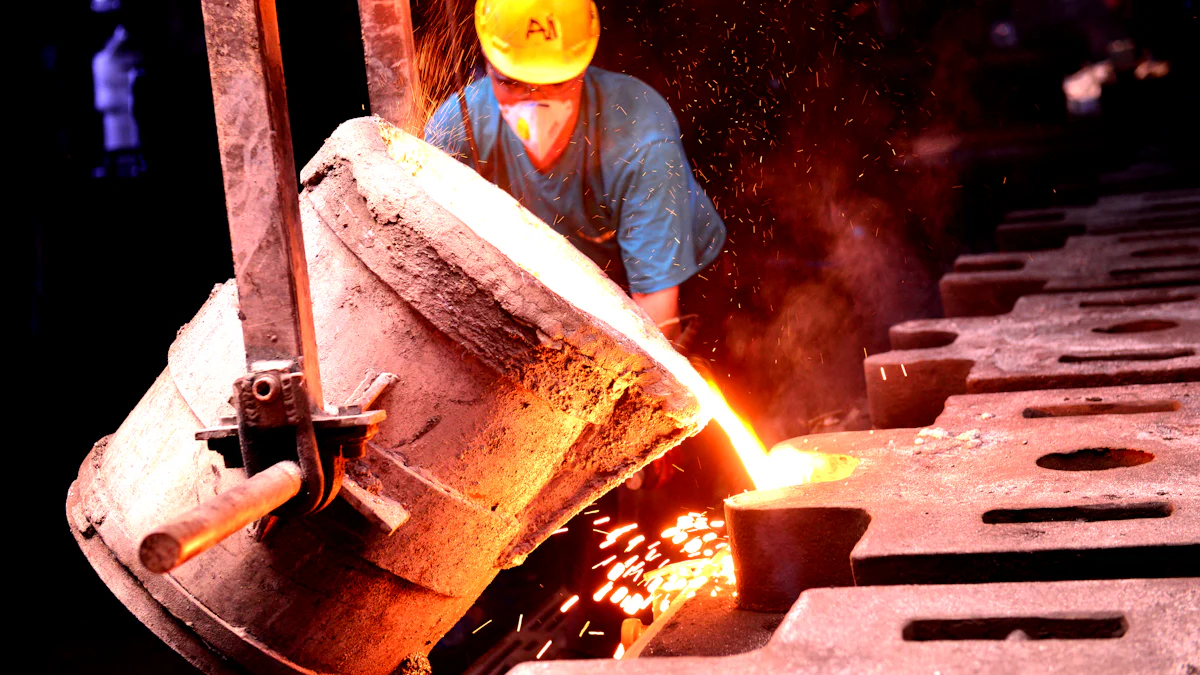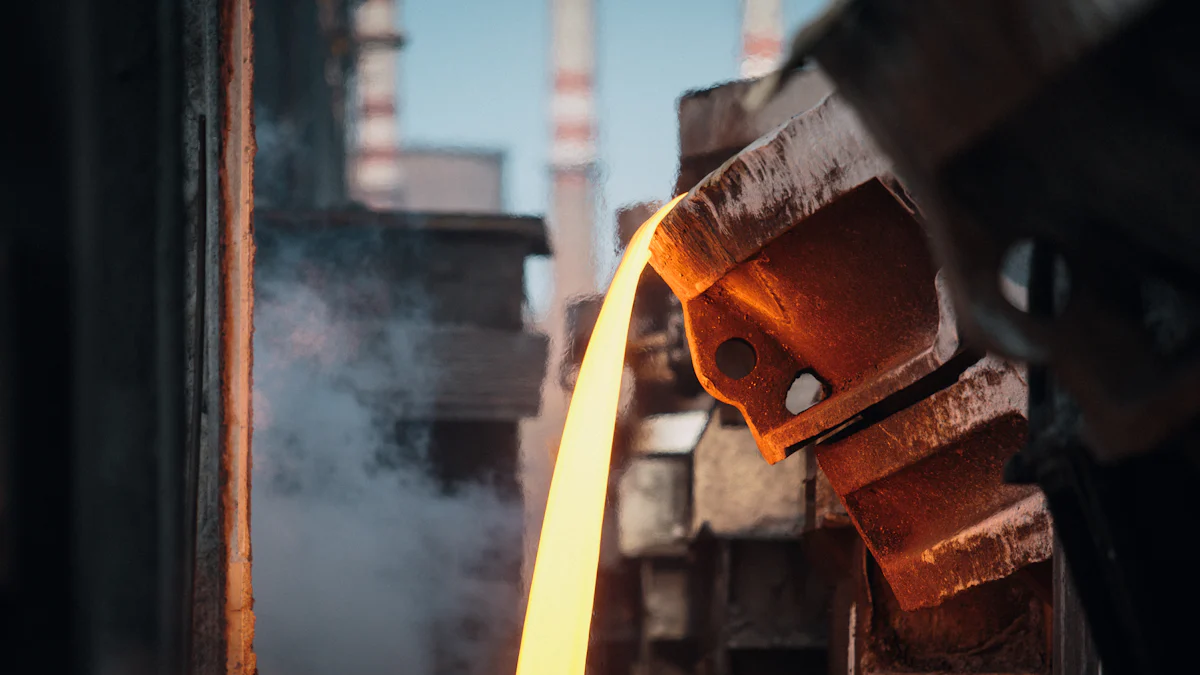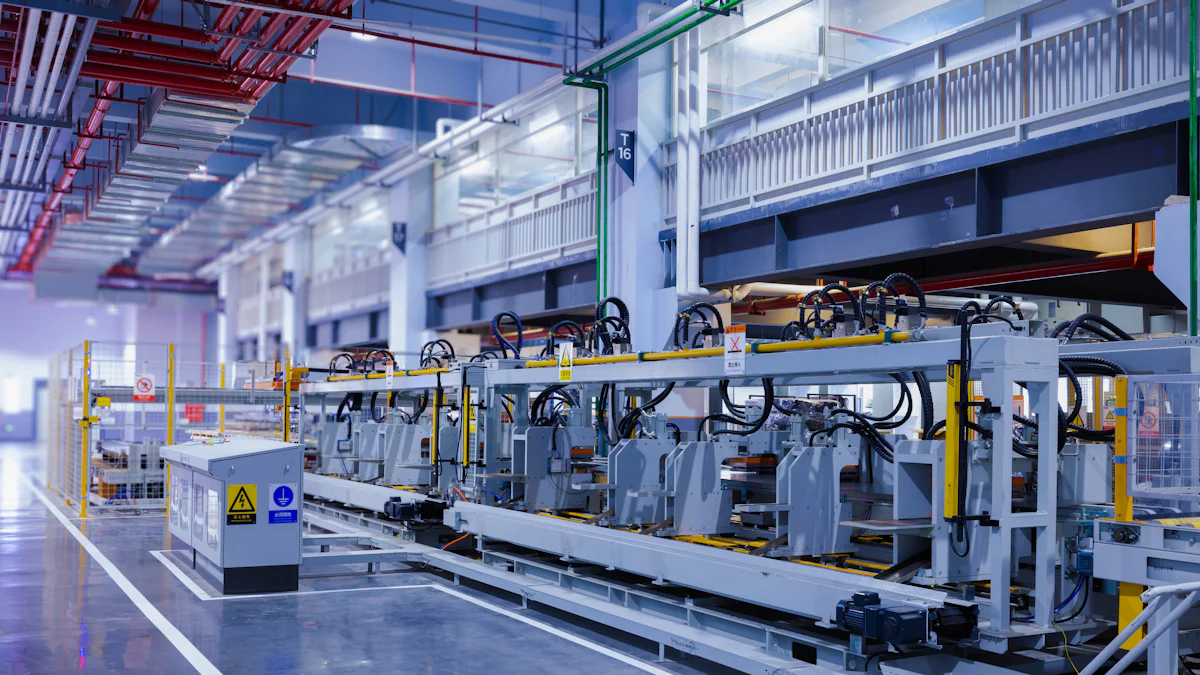How to Determine the Best Die Casting Closing Force for Your Product

What is Die Casting Closing Force and Why Does It Matter?
Definition and Function of Die Casting Closing Force
Die casting closing force refers to the pressure applied by a die casting machine to keep the mold securely closed during the injection of molten metal. This force ensures that the mold remains sealed, preventing any leakage or deformation caused by the high-pressure injection process. The molten metal enters the mold cavity at high speed and pressure, which generates an expansion force. The closing force must exceed this expansion force to maintain the integrity of the mold and ensure proper casting.
The calculation of die casting closing force involves key parameters such as the projected area of the product and the specific injection pressure. For example, multiplying the projection area of the casting on the mold's parting surface by the required injection pressure provides the necessary clamping force. This calculation ensures that the mold does not open unexpectedly during production, which could compromise product quality and operational reliability.
Importance of Closing Force in Ensuring Product Quality and Machine Performance
Accurate determination of the die casting closing force is critical for achieving high product quality and maintaining performance stability. When the closing force is insufficient, the mold may open slightly during the injection process, leading to defects such as flash or incomplete filling. These issues directly impact the durability and reliability of the final product.
On the other hand, excessive closing force can strain the machine, reducing its durability and increasing maintenance costs. By calculating the optimal closing force, you can achieve a satisfactory yield while ensuring the machine operates within its technical limits. This balance not only enhances product quality but also supports long-term operational reliability.
How Closing Force Relates to the Scale of Die Casting Machines
The scale of a die casting machine is determined by its clamping force capacity, typically measured in tons. Machines range from small-scale units with a clamping force of 25 tons to large-scale machines exceeding 3,000 tons. Selecting the right machine scale depends on the casting technical requirements of your product, including its size, shape, and material.
For small-scale operations, machines with lower clamping force are usually sufficient. However, high-volume production or products with complex designs may require machines with higher tonnage to meet the operating conditions and technical requirements. Ensuring the machine's clamping force aligns with your product's needs guarantees performance stability and compatibility with die casting process specifications.
By understanding the relationship between closing force and machine scale, you can make informed decisions that optimize both product quality and machine efficiency.
Step-by-Step Guide to Calculating Die Casting Closing Force

Step 1: Calculate the Projection Area of the Product
The first step in determining the die casting closing force is calculating the projection area of your product. The projection area refers to the two-dimensional surface area of the product as it appears on the mold's parting line. This area directly impacts the clamping force required during the die casting process.
To calculate the projection area, measure the length and width of the product's largest face that aligns with the mold's parting surface. Multiply these dimensions to obtain the area in square millimeters or square inches. For irregularly shaped products, divide the surface into smaller geometric shapes, calculate their individual areas, and sum them up. Accurate measurement ensures that the die casting parameters align with the product's technical requirements.
Tip: Always include any additional features, such as runners or overflows, in the projection area calculation. These elements contribute to the total force required to keep the mold closed.
Step 2: Determine the Required Injection Pressure
Once you have the projection area, the next step is to determine the injection pressure. Injection pressure refers to the force exerted by the molten metal as it enters the mold cavity. This pressure depends on the type of material used and the complexity of the casting.
For general parts, the injection pressure typically ranges between 30 and 50 MPa. Load-bearing components may require 50 to 80 MPa, while gas-tight parts often demand 80 to 100 MPa. Use these ranges as a guideline to select the appropriate pressure for your product. Multiply the projection area by the chosen injection pressure to calculate the initial clamping force.
Example: If your product has a projection area of 500 cm² and requires an injection pressure of 60 MPa, the initial clamping force would be 500 × 60 = 30,000 kN.
Step 3: Apply a Safety Factor for Optimal Performance
The final step involves applying a safety factor to ensure optimal performance during die casting production. A safety factor accounts for variations in production conditions, such as higher injection speeds, elevated mold temperatures, or increased complexity in design. It provides a buffer to prevent issues like mold deformation or leakage.
For most products, a safety factor between 1.0 and 1.3 is sufficient. Thin-walled or highly complex castings may require a higher safety factor due to the greater impact on the mold's parting surface. Multiply the initial clamping force by the safety factor to determine the final die casting closing force.
Example: Using the previous calculation of 30,000 kN, applying a safety factor of 1.2 would result in a final clamping force of 30,000 × 1.2 = 36,000 kN.
By following these steps, you can accurately calculate the die casting closing force required for your product. This ensures that the die casting parameters meet the technical requirements of your production, leading to better product quality and machine performance.
Example Calculation: Determining Closing Force for a Sample Aluminum Product
To better understand how to calculate the die casting closing force, let’s walk through an example using a sample aluminum product. Aluminum is widely used in die casting due to its lightweight nature, excellent corrosion resistance, and ability to maintain strength at high temperatures. These properties make it an ideal choice for industries like automotive and aerospace.
Step 1: Calculate the Projection Area
Imagine you are working with an aluminum component designed for an automotive application. The product has a rectangular shape with dimensions of 20 cm by 15 cm on its largest face. To calculate the projection area:
Multiply the length (20 cm) by the width (15 cm).
The projection area equals 300 cm².
If the product includes additional features like runners or overflows, you must add their areas to the total. For simplicity, let’s assume no extra features in this example.
Step 2: Determine the Required Injection Pressure
Next, you need to determine the injection pressure. Aluminum alloys used in high-pressure die casting typically require injection pressures ranging from 50 to 80 MPa, depending on the complexity and strength requirements of the product. For this example, let’s select an injection pressure of 70 MPa, as the component must withstand high operating temperatures and maintain dimensional stability.
Now, calculate the initial clamping force:
Multiply the projection area (300 cm²) by the injection pressure (70 MPa).
Convert the units: 1 MPa = 10 N/mm², so 70 MPa = 700 N/cm².
The initial clamping force equals 300 × 700 = 210,000 N, or 210 kN.
Step 3: Apply a Safety Factor
To ensure optimal performance, apply a safety factor. Aluminum products often require a safety factor between 1.1 and 1.3 due to their thin walls and complex designs. Let’s use a safety factor of 1.2 for this calculation:
Multiply the initial clamping force (210 kN) by the safety factor (1.2).
The final die casting closing force equals 210 × 1.2 = 252 kN.
This result indicates that you need a die casting machine with a minimum clamping force of 252 kN to produce this aluminum component effectively. Selecting a machine with slightly higher tonnage ensures a performance margin, which is crucial for maintaining efficiency and quality during production.
Note: Aluminum’s unique properties, such as its recyclability and resistance to corrosion, make it a popular material for structural die castings. These characteristics also influence the required closing force, especially for components exposed to outdoor environments or high stress.
By following these steps, you can confidently calculate the closing force for your aluminum product. This process ensures that your production setup aligns with the technical requirements of the material and design.
How Product Characteristics Influence Die Casting Closing Force
Impact of Product Size, Shape, and Weight
The size, shape, and weight of your product play a significant role in determining the required die casting closing force. Larger products naturally have a greater projection area on the die casting mold, which increases the expansion force during the injection process. This means you will need a higher clamping force to keep the mold securely closed.
The shape of your product also affects the calculation. Simple shapes with uniform surfaces distribute pressure evenly across the mold, requiring less force. However, irregular or complex shapes create uneven pressure distribution, increasing the risk of mold deformation. You must account for these variations when calculating the closing force.
Weight is another critical factor. Heavier products often require more molten metal, which generates higher injection pressure during the die casting process. This added pressure demands a stronger clamping force to maintain mold integrity. By carefully evaluating these characteristics, you can ensure that your die casting production setup meets the technical requirements of your product.
Tip: Always measure the largest face of your product for projection area calculations. Include any additional features like runners or overflows to avoid underestimating the required force.
Role of Material Type (e.g., Aluminum, Zinc) in Closing Force Requirements
The material you choose for your product significantly influences the die casting closing force. Different materials have unique properties, such as density, melting point, and flow behavior, which affect the injection pressure during the high-pressure die casting process.
For example, aluminum is lightweight and has excellent flow characteristics, making it ideal for thin-walled or intricate designs. However, its lower density means it requires moderate injection pressure, typically ranging from 50 to 80 MPa. Zinc, on the other hand, is denser and flows differently, often requiring higher injection pressure to fill the mold cavity completely. These differences directly impact the clamping force needed to prevent mold opening.
When selecting a material, consider its compatibility with your product's design and functional requirements. Matching the material properties with the die casting mold specifications ensures optimal performance and reduces the risk of defects.
Example: If you are producing an automotive component using aluminum, you can expect lower clamping force requirements compared to a similar component made from zinc. This makes aluminum a cost-effective choice for lightweight applications.
How Wall Thickness and Design Complexity Affect Force Calculations
Wall thickness and design complexity are critical factors in determining the die casting closing force. Thin walls require higher injection pressure to ensure the molten metal fills the mold cavity completely. This increased pressure translates to a higher clamping force to keep the die casting mold closed during production.
Complex designs with intricate details or sharp edges also demand more force. These features create localized stress points on the mold's parting surface, increasing the risk of deformation or leakage. You must account for these stresses when calculating the required clamping force.
To address these challenges, apply a safety factor during your calculations. This buffer compensates for the additional pressure caused by thin walls or complex designs, ensuring the mold remains stable throughout the die casting process.
Pro Tip: For highly detailed or thin-walled products, consider using high-pressure die casting machines with advanced features. These machines provide the precision and force needed to handle challenging designs effectively.
By understanding how product characteristics like size, material, and design influence the die casting closing force, you can make informed decisions that optimize your production process. This approach ensures high-quality results while maintaining the efficiency and reliability of your equipment.
Choosing the Right Scale of Die Casting Machine for Your Production Needs
Matching Machine Tonnage to Closing Force Requirements
Selecting the correct tonnage of a die casting machine is essential for achieving optimal results in the die casting process. The tonnage refers to the clamping force the machine applies to keep the mold securely closed during the injection of molten metal. To determine the appropriate tonnage, you must consider factors such as the projection area of your product, the required injection pressure, and the safety factor.
For example, if your product has a large projection area or requires high injection pressure, you will need a machine with higher tonnage to ensure the mold remains sealed. Machines typically range from 400 tons to 4,000 tons, with larger machines suited for products with greater complexity or size. Using a machine with insufficient tonnage can lead to defects like flash or incomplete filling, while excessive tonnage may waste resources and increase production costs.
Tip: Always calculate the required clamping force based on your product's technical specifications. This ensures the tonnage aligns with your production requirements and prevents operational inefficiencies.
Considering the Production Scale of Die-Casting Parts
The production scale of die-casting parts plays a significant role in choosing the right die casting machine. For small-scale production, machines with lower tonnage and moderate cycle times are often sufficient. These machines provide cost-effective solutions for producing smaller batches of parts without compromising quality.
In contrast, high-volume production demands machines with higher tonnage and faster cycle times. These machines can produce more parts per hour, making them ideal for industries like automotive or consumer electronics, where efficiency and speed are critical. Additionally, high-volume operations benefit from machines with advanced features that enhance precision and reduce downtime.
When evaluating your production scale, consider the number of parts you need to produce, the complexity of the designs, and the material used. This approach ensures the selected machine meets your production goals while maintaining cost efficiency.
Example: If you are manufacturing lightweight components using an aluminum die casting machine, a smaller machine with moderate tonnage may suffice for limited production runs. However, for large-scale operations, a high-tonnage machine ensures consistent quality and faster output.
Evaluating Machine Features for High-Volume vs. Small-Scale Production
Understanding the types and characteristics of die casting machines helps you select the right equipment for your production needs. High-volume production benefits from machines with advanced features like rapid cycle times, precise control systems, and high clamping force. These features enable the production of thin-walled or intricate designs with minimal defects.
For small-scale production, simpler machines with fewer features may be more practical. These machines often have lower tonnage and are easier to operate, making them suitable for producing smaller quantities of parts. However, even for small-scale operations, it is crucial to ensure the machine's clamping force matches the product's requirements to maintain quality.
When comparing machines, evaluate factors such as die size compatibility, piston stroke, and shot pressure. These specifications directly impact the effect of the selected die-casting machine on your production efficiency and product quality. By aligning machine features with your production requirements, you can achieve better results and reduce operational costs.
Pro Tip: For aluminum components, consider machines designed specifically for aluminum die casting. These machines offer the precision and durability needed to handle the unique properties of aluminum, ensuring high-quality results.
Ensuring Compatibility Between Mold Size and Machine Specifications
Ensuring that your mold size aligns with the specifications of your die casting machine is essential for achieving efficient and defect-free production. A mismatch between the two can lead to operational inefficiencies, increased wear on equipment, and compromised product quality. To avoid these issues, you need to evaluate several critical factors.
1. Match the Mold Dimensions with the Machine’s Platen Size
The platen size of a die casting machine determines the maximum mold dimensions it can accommodate. The mold must fit securely within the machine’s platens to ensure proper clamping and alignment during the casting process. Measure the mold’s length, width, and height, and compare these dimensions with the machine’s platen specifications. Always leave a margin to account for any additional components, such as ejector pins or cooling systems.
Tip: If your mold includes complex features or multiple cavities, ensure the platen size provides enough space for uniform pressure distribution across the mold surface.
2. Ensure Clamping Force Supports Mold Requirements
The clamping force of the machine must exceed the expansion force generated by the molten metal during injection. Larger molds or those used for high-pressure applications require machines with higher clamping force. Calculate the required clamping force based on the mold’s projection area and injection pressure, then verify that the machine’s tonnage meets or exceeds this value.
Example: A mold with a large projection area used for aluminum casting may require a machine with a clamping force of 800 tons or more to maintain mold integrity.
3. Check Injection System Compatibility
The injection system of the die casting machine must align with the mold’s design and material requirements. For instance, molds designed for high-pressure die casting need machines capable of delivering precise and consistent injection speeds. Evaluate the machine’s shot capacity and injection pressure to ensure they match the mold’s cavity volume and material flow characteristics.
Pro Tip: For molds with intricate designs or thin walls, prioritize machines with advanced injection systems that offer better control over molten metal flow.
4. Account for Mold Preparation Needs
Proper mold preparation is crucial for maintaining compatibility and extending the mold’s lifespan. Before production, clean the mold thoroughly to remove debris or residues. Lubricate the interior walls to facilitate smooth ejection of cast parts and regulate the mold temperature to prevent thermal stress. These steps ensure the mold performs optimally within the machine’s operating parameters.
5. Evaluate Long-Term Production Goals
Consider your production scale and future needs when selecting a die casting machine. If you plan to scale up production or use larger molds, choose a machine with a performance margin. This ensures the machine can handle increased demands without compromising efficiency or quality.
By carefully assessing these factors, you can ensure that your mold and die casting machine work seamlessly together. This compatibility not only enhances production efficiency but also reduces downtime and maintenance costs, leading to higher-quality castings and improved operational reliability.
Practical Examples of Die Casting Machine Selection

Example 1: Small-Scale Production with a Lightweight Aluminum Die Casting Machine
For small-scale production, selecting the right die casting machine ensures efficiency and cost-effectiveness. Imagine you are producing lightweight aluminum components for consumer electronics. These parts often have simple designs and moderate size, making them ideal for a smaller aluminum die casting machine. Machines with lower tonnage, such as those in the 200T to 400T range, are well-suited for this type of production.
A lightweight aluminum die casting machine offers several advantages. It consumes less energy, requires minimal maintenance, and operates efficiently for smaller batches. These machines also provide precise control over the injection process, ensuring consistent quality for each part. By choosing a machine that matches your production scale, you can minimize waste and reduce operational costs.
Tip: Always verify that the machine’s clamping force aligns with the projection area and injection pressure of your product. This ensures the mold remains secure during the casting process.
Example 2: High-Volume Production Requiring a Large-Scale Machine
High-volume production demands a die casting machine capable of handling large quantities with speed and precision. For instance, if you are manufacturing automotive components like engine housings or transmission cases, you need a machine with higher tonnage, typically ranging from 1,000T to 4,000T. These machines can produce complex parts to tight tolerances while maintaining excellent surface finishes.
Large-scale machines excel in high-pressure environments, making them ideal for industries requiring mass production. They feature rapid cycle times, allowing you to produce more parts per hour. This efficiency reduces production costs and ensures timely delivery of large orders. Additionally, these machines often include advanced features like automated systems for mold cooling and part ejection, further enhancing productivity.
Pro Tip: When selecting a machine for high-volume production, prioritize models with robust construction and reliable performance. This ensures long-term durability and minimizes downtime.
Example 3: Complex Designs with Thin Walls and High Precision Requirements
Producing intricate components with thin walls requires a specialized die casting machine. For example, aerospace or medical devices often involve complex designs that demand high precision. In such cases, an aluminum die casting machine with advanced capabilities is essential. These machines provide the high clamping force and precise injection control needed to handle challenging designs.
Thin-walled components require higher injection pressure to ensure complete filling of the mold cavity. A machine with features like real-time monitoring and adjustable injection speeds can help achieve this. These capabilities reduce the risk of defects such as porosity or incomplete filling. Additionally, machines designed for precision casting often include enhanced cooling systems, which maintain dimensional stability and improve surface quality.
Example: If you are producing an aluminum component with intricate details, select a machine with a clamping force of at least 800T. This ensures the mold remains stable under high pressure, delivering consistent results.
By understanding the specific requirements of your production, you can choose a die casting machine that aligns with your goals. Whether you need a lightweight aluminum die casting machine for small-scale production or a high-tonnage machine for complex designs, selecting the right equipment ensures efficiency, quality, and cost savings.
Common Mistakes to Avoid When Selecting Die Casting Closing Force
Underestimating the Required Closing Force for Larger Products
Underestimating the required die casting closing force can lead to significant production issues. Larger products naturally have a greater projection area, which increases the expansion force during the injection process. If the closing force is insufficient, the mold may open slightly, causing defects such as flash or incomplete filling. These defects compromise the precision and quality of the final product.
To avoid this mistake, always calculate the required closing force based on the product's projection area and the expected injection pressure. Ensure that the calculated force does not exceed the machine's maximum locking capacity. Operating under conditions where the expansion force surpasses the machine's locking force can result in mold damage or production failures. By accurately determining the closing force, you can maintain product integrity and prevent costly errors.
Tip: Double-check your calculations and include a safety factor to account for variations in production conditions, such as changes in material flow or mold temperature.
Overcompensating with Excessive Closing Force and Its Consequences
Using excessive closing force may seem like a safe approach, but it often creates more problems than it solves. Applying too much pressure can force molten metal into tiny crevices of the mold, leading to flash formation around the part. Removing this excess material requires additional time and labor, increasing production costs. Moreover, excessive force accelerates mold wear and tear, reducing its lifespan and increasing maintenance expenses.
To prevent overcompensation, select a closing force that aligns with the product's technical requirements. Avoid exceeding the necessary force by a wide margin. Instead, apply a reasonable safety factor to ensure optimal performance without overloading the machine. This approach minimizes the risk of mold damage and ensures efficient production.
Pro Tip: Regularly inspect your molds for signs of wear or damage caused by excessive pressure. Early detection can help you address issues before they escalate.
Ignoring Safety Factors or Variations in Production Conditions
Ignoring safety factors is a common oversight that can lead to production inconsistencies and equipment failures. Safety factors account for unexpected variations in production conditions, such as higher injection speeds, elevated mold temperatures, or changes in material properties. Without this buffer, you risk operating at the machine's limits, which increases the likelihood of defects or breakdowns.
To avoid this mistake, always include a safety factor in your calculations. For most products, a safety factor between 1.0 and 1.3 is sufficient. Thin-walled or complex designs may require a higher safety factor due to the increased stress on the mold. By incorporating this margin, you can ensure stable and reliable production, even under challenging conditions.
Example: If your calculated closing force is 500 kN, applying a safety factor of 1.2 would result in a final force of 600 kN. This adjustment provides a buffer to handle variations without compromising quality.
By addressing these common mistakes, you can optimize your die casting process and achieve better results. Accurate calculations, balanced force application, and consideration of safety factors ensure high-quality production while protecting your equipment and molds.
Troubleshooting Issues Related to Die Casting Closing Force
Identifying Signs of Insufficient Closing Force During Production
Insufficient die casting closing force often leads to noticeable defects in your production process. Recognizing these signs early can save you time and resources. One common indicator is the presence of flash, which occurs when molten metal leaks out of the mold due to inadequate clamping force. Flash not only affects the appearance of the product but also increases post-production costs for trimming and finishing.
Another sign to watch for is incomplete filling of the mold cavity. When the mold does not stay securely closed, the molten metal may fail to reach all areas of the cavity, resulting in parts with missing sections or weak structural integrity. Additionally, you might notice irregularities in the product's surface, such as warping or uneven textures, caused by the mold shifting during injection.
Tip: Regularly inspect your products for these defects. If you observe any of these issues, reevaluate the clamping force settings on your machine to ensure they meet the requirements of your production.
Adjusting Machine Settings to Optimize Performance
Optimizing your machine settings can resolve many issues related to die casting closing force. Start by recalculating the required clamping force based on the projection area of your product and the injection pressure. Ensure that the machine's tonnage matches or slightly exceeds this calculated force. If the machine's capacity falls short, consider using a different machine with higher tonnage.
Next, check the alignment of the mold within the machine. Misaligned molds can reduce the effectiveness of the clamping force, leading to defects. Adjust the mold's position to ensure even pressure distribution across the parting surface. Also, verify that the mold is clean and free from debris, as contaminants can interfere with proper sealing.
You should also review the injection speed and pressure settings. Excessive injection pressure can overwhelm the clamping force, causing the mold to open slightly. Reduce the injection pressure to a level that maintains mold integrity without compromising the quality of the casting.
Pro Tip: Perform regular maintenance on your die casting machine to keep all components in optimal condition. Well-maintained equipment ensures consistent performance and minimizes the risk of production issues.
When to Consult a Die Casting Expert for Assistance
Sometimes, troubleshooting on your own may not resolve the issues related to die casting closing force. In such cases, consulting a die casting expert can provide valuable insights and solutions. Experts can analyze your production setup, identify underlying problems, and recommend adjustments to improve efficiency and quality.
For instance, if you consistently experience defects despite recalculating the clamping force and adjusting machine settings, an expert can help you evaluate whether the mold design or material choice is contributing to the problem. They can also guide you in selecting a machine that better suits your production needs, especially if your current equipment lacks the necessary capacity.
Example: If you are producing thin-walled components with intricate designs, an expert might suggest using a high-pressure die casting machine with advanced features to handle the increased demands on the mold.
Reaching out to a professional not only helps you address immediate concerns but also equips you with knowledge to prevent similar issues in the future. This proactive approach ensures smoother operations and higher-quality results in your die casting process.
Accurately calculating the die casting closing force is essential for ensuring high-quality production and efficient machine performance. By following the key steps—calculating the projection area, determining the injection pressure, and applying a safety factor—you can achieve precise results tailored to your product's needs. Always consider factors like product characteristics, production scale, and the specifications of your die casting machine. For small-scale operations, an aluminum die casting machine offers efficiency and cost-effectiveness, while high-volume production may require machines with greater tonnage. Consulting experts or manufacturers can help you select the right equipment at the best price, ensuring long-term success in your die casting process.
FAQ
What is clamping force in die casting, and why is it important?
Clamping force refers to the pressure applied by the die casting machine to keep the mold securely closed during the injection process. This force counteracts the separating force generated by molten metal inside the cavity. Without sufficient clamping force, the mold may open slightly, leading to defects like flash or incomplete filling. Ensuring the correct clamping force is vital for maintaining product quality and mold integrity.
How are die casting machines rated, and what specifications should you consider?
Die casting machines are rated based on their clamping force, which typically ranges from 25 tons to 3,000 tons or more. When selecting a machine, you should also evaluate other specifications, such as the die size, piston stroke, and shot pressure. These factors influence the machine's compatibility with your mold and production requirements.
Tip: Always match the machine's specifications with the technical needs of your product to ensure efficient and defect-free production.
What factors should you consider when determining the appropriate tonnage for a die casting machine?
Several factors influence the selection of the right tonnage, including the projection area of the product, expansion force, fill ratio, and mold dimensions. Choosing a machine with insufficient tonnage can lead to unstable casting quality, while excessive tonnage may waste resources and increase costs. Striking the right balance ensures optimal performance and cost efficiency.
Why is it crucial to calculate the required locking force?
Calculating the required locking force ensures that the die casting machine can withstand the expansion force generated during the injection process. This calculation involves multiplying the projected area of the casting by the expected injection pressure. Operating under conditions where the expansion force exceeds the machine's locking force can result in mold damage and production failures.
What role does tonnage play in pressure die casting?
Tonnage plays a critical role in ensuring proper mold clamping, part integrity, cooling efficiency, and part ejection. The tonnage must be sufficient to keep the mold closed during high-pressure injection. Factors like part geometry, material properties, and gate design influence the tonnage calculation. Selecting the right tonnage ensures smooth operations and high-quality results.
When selecting a die casting machine, what process structures should you consider?
You should ensure that the expansion force during production does not exceed the machine's locking force. This prevents the mold from opening unexpectedly, which could compromise product quality. Additionally, consider the mold's design and material flow characteristics to align with the machine's capabilities.
What happens if you underestimate the required closing force?
Underestimating the closing force can lead to defects such as flash, incomplete filling, or mold deformation. These issues compromise the structural integrity and appearance of the final product. To avoid this, always calculate the required force accurately and include a safety factor to account for variations in production conditions.
Can using excessive closing force cause problems?
Yes, excessive closing force can lead to issues like flash formation, increased mold wear, and higher maintenance costs. It may also waste energy and resources. To prevent these problems, calculate the required force carefully and apply a reasonable safety factor without overcompensating.
How do material properties affect the required closing force?
The material used in die casting significantly impacts the required closing force. For example, aluminum typically requires moderate injection pressure due to its lightweight nature, while denser materials like zinc may demand higher pressure. Understanding the material's properties helps you select the right machine and optimize the casting process.
When should you consult a die casting expert?
If you encounter persistent defects or challenges despite adjusting machine settings and recalculating the closing force, consulting a die casting expert is advisable. Experts can analyze your production setup, identify underlying issues, and recommend tailored solutions. Their guidance ensures smoother operations and better results in your die casting process.
Pro Tip: Seeking expert advice early can save time and resources while improving overall production efficiency.
See Also
Understanding Functional Testing in CNC and Die Casting
Seven Essential Steps to Collaborate with Global Diecast Factories
The Importance of QFD, FMEA, and DOE in Quality Manufacturing
Leading Aluminum Labels in the US, EU, and China
Understanding MOQ and Its Effect on RFQs
About Hunan Puka
Established in 2016 and based in Hunan, China, with a liaison point in Berlin, we are a Tier 2 supplier for the automobile industry. We specialize in the production of customized aluminum die-casting parts designed for machines with a closing force ranging from 280 to 800 tons, with subsequent manufacturing process CNC machining and surface treatment. Our commitment to quality is reflected in our accredited quality management system, certified by ISO9001:2015 and IATF16949:2016 standards.


